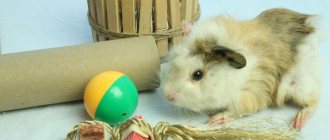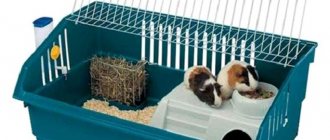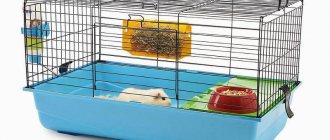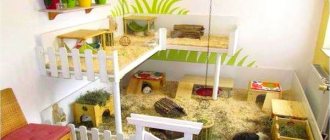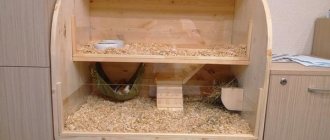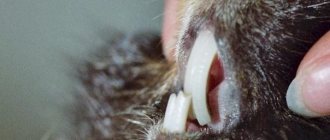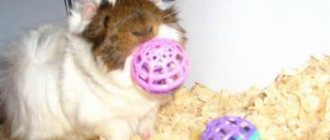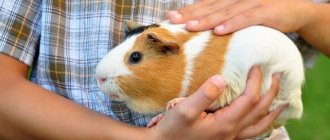- home
- Guinea pig
- Guinea pig breeding
02/07/2019 Determining the sex of a guinea pig is not a difficult task. But its implementation requires knowledge and skills. In addition to direct sexual characteristics, gender is determined by indirect characteristics. Sex determination is important in further control of animal breeding. At the age of 1 month, pigs become sexually mature. This means that they are capable of reproducing uncontrollably if they are not separated according to gender in time.
How to find out the gender of a guinea pig
To do this, you need to examine your pet. You can find out the sex of a rodent using the following methods:
- pay attention to the pet’s intimate organs;
- Examine the animal's mammary glands;
- examine their anus.
Important: if the pet is frightened and breaks out of your hands, it is recommended to reschedule the examination to another time, when the animal is calmer.
Guinea pigs are quite shy and do not like to be grabbed and forcibly held in an uncomfortable position. To ensure that the animal is exposed to as little stress as possible, it is necessary to carry out the inspection procedure quickly and without sudden movements.
You also need to follow the inspection rules:
- Before performing the procedure, you should wear sterile, disposable gloves. In the case of examining two pets, gloves must be changed, since the presence of harmful microbes may be present on the genitals of rodents. To avoid spreading the infection to another pet, it is necessary to follow the rules of hygiene.
- To examine the genital organs, it is recommended to lay the guinea pig on its back, holding it in the palm of your hand. To prevent the animal from falling, it is necessary to hold it in the chest area.
- When the pet is fixed in this position, it is necessary to carefully examine its genitals, slightly moving the skin of the lower abdomen with your fingers.
- When the procedure is completed, the pet should be returned to the cage and be sure to give him his favorite treat.
The differences are shown in the diagram
How to tell if it's a boy or a girl by their genitals
A common way to examine the genitals is to remove the mucous membrane: you need to apply a little pressure on the very bottom of the rodent’s belly, after first placing the animal towards the top with its paws in your palm. If it is a boy, you can see the penis in the form of a small protrusion. In girls, part of the mucous membrane will open.
Females have a small genital organ and a slightly convex shape. The genital slit becomes thinner towards the tail and resembles the shape of the Latin letter Y.
The male genital organ is a rounded place, in the upper part of which a point is visible - this is the genital shaft of the animal. It can be felt quite easily by lightly pressing on the bottom of the pet’s tummy.
In boys, it is also easy to feel the testicles and scrotum. It looks like a small, convex sac and is located between the reproductive organ and the anus.
Attention! If you do not know how to determine the sex of guinea pigs and purchase a pet from unverified breeders, it is possible to have a “pig in a poke” by taking an opposite-sex pair or a pregnant female.
By the anal sac
Males need it to mark territory. They secrete a strong-smelling enzyme from the anal gland. Therefore, the anus of males is well developed and has a brown or gray color.
Females do not make marks and their anal sac is a rudiment: an atrophied organ that is quite difficult to see.
If during the examination you find a large anal sac in your client, you can be sure that this is a male representative.
Can be identified by the shape of the excrement
We determine gender by the shape of the litter
This method can also determine the gender of a guinea pig. The male's droppings, due to the structural features of the anus, have the shape of a crescent, narrowed at both ends and a groove along the entire length. Girls have even, oval-shaped litter.
This is only an additional method and is suitable for clarifying the belonging of a group of healthy pigs to the same sex or for determining the sex of a separately separated, but also healthy guinea pig.
Note: it should be noted that sex determination based on the shape of the litter is reliable for guinea pigs with healthy digestion.
Determining the sex of a guinea pig by indirect signs
To determine gender in this way, you should observe your pet for a certain period. When observing, you should pay attention to the behavior of the animal: females always remain calm and friendly. Boys, on the contrary, are more aggressive; they often display dominant behavior and rumble. During heat (1-2 times every few weeks) they can jump on other guinea pigs.
Males are also larger in size: the weight of an adult sometimes reaches one and a half kilograms; he has a strong skeleton and a massive head. Girls, on the contrary, have less weight (no more than a kilogram), they are small in size; the head and skeleton are more refined.
Inspection before 3 weeks is strictly prohibited
Couple or family
Guinea pigs can be bred monogamously or in a harem way. With the monogamous method, a male and a female are selected. Such a pair will eventually become inseparable, but this does not mean that the female will not have to be separated from the male. The first reason why a female may need a separate cage is the boy’s aggressiveness towards newborn cubs.
We invite you to read: Detailed description of the British Longhair cat or Highlander
If you plan to breed guinea pigs as a business, then you should resort to harem housing.
In this case, there are up to ten females per male. The harem method is more effective because it allows you to get more offspring. The downside is that several separate cages are required for pregnant females. The entire harem can be kept in one cage, but its size must be really large.
If the family consists of one male and five females, then the cage must be at least two meters long, at least 75 cm wide, and have two tiers, each 40 cm high. The number of houses should be equal to the number of females. With this method of keeping, females can feed and care for all children, without dividing them into their own and others.
Determining the sex of a guinea pig at a young age
Attention! Examination of guinea pigs under 3 weeks of age is strictly prohibited. The smell of human hands remains on the animal’s fur, which contributes to the mother’s refusal to breastfeed this baby. This could be fatal for him.
To determine the sex of the baby, you need to place it on your arm, belly up, and visually measure the distance between the anus and the urethra. In females it is significantly less than in representatives of the opposite sex.
It is worth noting that boys have several skin folds in the genital area, while girls do not have them.
Have you found it difficult to determine the gender of your pig?
Features of feeding
It is known that guinea pigs are domesticated rodents that feed on dry grass. The basis of their diet is hay. In addition, animals eat grain feed:
- oats;
- corn;
- barley;
- wheat;
- sunflower seeds.
It is beneficial for animals to eat vegetables and fruits, as well as fresh herbs. These are valuable sources of vitamins and microelements. In winter, rodents are given grass pellets or grain sprouts. The diet must include branches of fruit trees.
Guinea pigs should not be offered food of animal origin, as well as potatoes, red beets, and citrus fruits. Confectionery and bakery products are strictly prohibited.
Determining the sex of a guinea pig at an older age
During adulthood, choosing an animal based on its gender is much easier. The scrotum of a male representative is quite clearly expressed. There is a clear visibility of the external genitalia. In females, when pressing on the abdomen, the genital slit is visible. The reproductive organs of the male are much larger than those of the females.
In representatives of both sexes, the mammary glands are clearly visible, but in females they are more pronounced and have a brighter color.
There are some differences in the behavior of boys and girls
Method No. 3 - by size and external features
It is no secret that adults and young individuals of different sexes are visually distinguishable. With guinea pigs, everything is not so simple - the younger the animals, the more similar they are, but there are some differences.
External signs:
- The head of females is narrower. Males have a wider forehead and cheekbones.
- The females have a “chiseled” figure, with a “waist” and wide hips. Males look “tighter”.
- Females are smaller, their weight rarely exceeds 1.2 kg. Males are much larger and weigh from 1.5 kg.
Males and females have nipples, but when young, they look the same. At sexual maturity, even if the female has not had cubs, her nipples have a more saturated color.
Differences in the behavior of boys and girls
In order to find out what the differences in behavior are, consider representatives of each gender.
First, let's look at the behavioral characteristics of the male. Boys are active, if there is a neighbor, competitions often occur, but for the most part, they do not harm the pets: this is a way to show their dominance. They do not tolerate loneliness quite well, so they require the attention of the owner or living together with their own kind. It is good if it is an individual of the same litter or age. Males are very “talkative”: the desire to eat, play, the game itself is accompanied by various sounds. Sexual activity begins at 3 weeks and continues throughout life.
Girls are less active and affectionate. Just like males, they need constant attention. If you make two girlfriends, they will get along well: fights are possible, but very rare. Females make sounds less frequently than their opposite counterparts, mainly only when they are hungry. Puberty occurs at the age of four weeks, but mating is allowed from 5 months to 3 years.
Important: after 3 years of age, the risk of death during pregnancy increases.
Factors affecting the height and weight of an adult
The modern guinea pig has generally accepted standards, but its weight and size fluctuate due to a number of reasons.
Newborn pigs
Typically, at birth, the length of a baby pet is about 10 cm
. However, you need to take into account the number of piglets in the litter; the more cubs, the less growth. Length is influenced by priority; as a rule, large piglets are born first. An important factor is the well-being of the female during pregnancy.
In a couple of months after birth, a piglet can almost double in size, up to 15-20 cm. Then growth will slow down a little, but by six months the baby will stretch to 20-25 cm.
When it reaches one and a half years, the animal grows to 20-30 cm
. These parameters are final; the rodent is considered an adult.
Floor
A big factor influencing the size of an individual is gender. As with all animals, the male is larger and heavier than the female.
Breed
An important factor is the breed of the animal. The sizes of animals crossed during the selection process can be either miniature or quite large.
. Having large volumes, animals of the following breeds can boast from a kilogram:
- Coronet
- Peruvian
- Abyssinian
- Himalayan
- Ridgeback
Unfortunately, due to the great interest in rodents, the number of people who breed animals has increased. This has led to a slightly lower standard than that of rodents living in the wild.
Nutrition
Balanced nutrition and nutrition from the first days of life play a vital role in determining the weight and size, as well as the health of the pet. Fresh dried hay, fruits and vegetables rich in vitamins, twigs of bushes and root vegetables should be in the public domain. However, it is worth remembering that overfeeding is unacceptable.
which will lead to obesity.
Caring for a female
During pregnancy, the female requires special care. Immediately after crossing, she needs to be isolated from her relatives, if she previously lived more than one. There should always be fresh bedding in the cage. It must be changed at least once every 5 days.
Particular attention will need to be paid to the diet of the expectant mother. There should always be enough food in the cage. Here is a sample daily menu for a pregnant guinea pig:
- fresh vegetables - 50-70 g;
- dry food - 3-4 g;
- sprouted oats - 14-16 g;
- wheat - 5-6 g;
- fresh fruit - 25-30 gr.
It is important to monitor the female's drinking regime. There should always be a drinking bowl with clean water in the cage. As a source of vitamin C, it is useful to offer your pet 20-30 ml of rosehip decoction daily.
You will also need to protect the female from stress. For example, from an unplanned meeting with relatives or loud noise. You should handle a pregnant pet as rarely as possible.
The approach of birth is indicated by a change in the behavior of the pig - nesting, lack of appetite, severe thirst. The delivery process usually does not cause problems and is easy. However, you should always be in touch with a veterinarian, who will provide assistance to your pet if necessary.
Childbirth lasts just over an hour. A guinea pig gives birth while sitting. Cubs are born at intervals of 5-6 minutes. The new mother independently chews the birth membranes and licks the babies.
Important! Sometimes instinct fails and the guinea pig does not rupture the membranes. In such a situation, you can do it yourself with clean hands. Otherwise, the offspring will die.
After giving birth, the female and cubs need rest. It is necessary to provide the mother of the family with sufficient food and water. Sometimes guinea pigs who give birth develop bald spots - this is a variant of the norm. In such a situation, you will need to wipe the problem areas with a clean cloth soaked in a weak solution of potassium permanganate. After about 2 weeks, the fur grows back.
Estrus
A female guinea pig is only ready to conceive within 12 hours of the start of her heat, which occurs every 14-18 days. The period favorable for fertilization can be determined by the following characteristics:
- the pig's genital loop swells;
- mucus discharges from the vulva;
- the pet raises the back of its body when stroking it;
- the pig makes a characteristic inviting rumbling sound.
You should also observe the female’s mood. Under normal conditions, rodents do not let males get close and often show aggression. During the period of estrus, the pig's behavior changes, she becomes more lenient and supportive of her boyfriend.
Pairing
When estrus occurs, the animals are boarded again for about a day. Once you are convinced of their friendly attitude towards each other, you can leave the pets so that they can quietly retire. Immediately before mating, mating flirtations occur: animals sniff each other, rub their heads, and purr.
If everything goes well, after some time the female takes a characteristic pose, raising the back of her body. The male, having received the signal, does not miss the opportunity and impregnates the partner. Mating lasts a few seconds. The number of cages is not limited.
With the end of estrus, the female's loop closes and the animals lose sexual activity and all interest in each other. From now on, it is necessary to place the guinea pigs in their own cages.
Indirect methods
If you have time to watch your pig, that's great, because you can distinguish guinea pigs by observation.
- Females behave calmly and peacefully, while males try to dominate and mount their partners. Females behave this way exclusively during the hunting period, which lasts only a day.
- An adult female guinea pig will weigh less than a male, its weight reaches 1200 grams, the weight of a male is 1500 grams.
- Males have larger bones and high withers.
When purchasing guinea pigs of different sexes, be sure to choose a male and female of the same breed.
If you want to have an easy-going pet, buy a boy. They are usually calm and phlegmatic, they do not need much attention and will always find entertainment for themselves. In addition, males are a little more intelligent, and therefore are faster and more willing to train. Females can be capricious, show jealousy and resentment. But they are more trusting and get used to hands faster if they feel that their owner really loves them.
Inexperienced owners of furry rodents often wonder how to determine the sex of a guinea pig at home.
After all, the sexual characteristics of these animals are so difficult to distinguish that pet store sellers or qualified veterinarians sometimes fail to cope with this task. What are the ways to determine the sex of a cute sea pet, and what character traits are inherent in female and male guinea pigs?
Acquaintance
Before moving directly to mating animals, it is necessary to introduce them. 6-7 days before the expected start of estrus, it is recommended to place the female and male cages side by side. This way they can take a closer look and smell each other. After another couple of days, you can organize several meetings on neutral territory (for example, in a separate cage).
The absence of aggression, especially on the part of the female, and the manifestation of mutual interest signals the rodents' readiness to create a pair. From this moment, you can begin to sit down a potential couple. This must be done in accordance with the following rules:
- For boarding, you need to purchase a new spacious cage without stairs or floors. As a last resort, you can place the female with the male.
- Before settling pigs in one territory, they should be bathed in order to neutralize the unfamiliar aroma of their neighbor.
- Before planting, you need to rub the future parents with hay with the smell of their partner. This will help them find a common language faster.
- The floor of the cage should be covered with enough hay and treats to prevent the pigs from having food conflicts. In addition, eating food together helps the rodents get closer together.
- On the first day of cohabitation, the owner should always be near the cage so that in case of a conflict, he can quickly seat the animals.
- It is recommended to seat the partners 1-2 days before the heat. This measure will increase the quality of the male’s sperm.
Important! If you cannot breed guinea pigs or crossing does not bring results for more than 6 months, you should think about selecting other partners for the animals.
Some guinea pig owners prefer not to waste time on preliminary introductions to their pets, and introduce their pets only on the day of the planned crossing. This is not recommended, since unprepared animals often get into bloody fights with a stranger.
Puberty
The onset of reproductive function in guinea pigs begins at 2 months. However, there is no need to rush into getting offspring. At such a young age, the female’s body is not yet fully strong enough to bear offspring and give birth. It is better to wait until your pet is at least six months old. There is also no point in delaying procreation. Late motherhood often causes hormonal imbalance.
Until mating, future parents must be kept in separate cages. Guinea pigs are characterized by increased sexual activity. If a female and a male live together, the breeding process will get out of control and will continue continuously.
Important! The interval between births should be at least 6 months. This time is quite enough for the complete restoration of the female’s body.
Let's sum it up
As a rule, when we buy a guinea pig, the seller informs us of what gender the animal is being sold, so we can only check how reliable the information is. Another thing is when we plan to breed these beautiful animals, then we will have to find out the sex of the animals ourselves.
Remember that cubs should not be picked up before the age of 1 month, as this can lead to dire consequences. Also, do not forget that the animal does not understand why you carry out such manipulations and what you want from it, so calm it down and treat it with treats so that it does not experience stress.
Genes responsible for color
Knowing the characteristics of the genes responsible for coat color, breeders can easily obtain offspring of guinea pigs of the desired color. The main genes that determine the color of future babies have the following designations:
- A - agouti;
- B – brown;
- C – color intensity;
- E – black and red colors;
- P – pink eyes and weak pigmentation;
- S – white.
The listed genes give rise to many mutations, the main types of which are presented in the table:
| Gene | Mutation | ||
| B | b | — | Brown coloring and ruby eyes |
| C | c(d) | — | Reduced color intensity: brown and gray tones instead of black |
| c(k) | — | Strong lightening of the base color | |
| c(r) | — | Neutralizes red pigments | |
| E | e(p) | — | Variegated colors |
| e | — | The presence of one red pigment and its weaker tones | |
| P | — | Lilac, beige, cream color | |
| S | — | Complete absence of white spots | |
| s(s) | — | Less than 50% white wool | |
| s | — | More than 50% white wool | |
| si | — | Silver color with white hairs | |
| gr | — | Intense silver color | |
| rs | — | Sick non-viable offspring are white | |
If the origin of guinea pigs is not known for certain, then the result of their crossing cannot be predicted. Since there is no reliable data on their genotype. For example, after mating black rodents, white, tortoiseshell, or red babies may appear.
Cubs
A brood of guinea pigs contains from 1 to 6 babies. Cubs are born mini copies of adults. They immediately have a full set of teeth, sharp claws, dense fur, and open eyes. The weight of newborns, depending on the breed, ranges from 30-120 g. The offspring do not require special care; the mother provides everything necessary.
During the feeding period, only 2 nipples are active in the female. Therefore, at first the babies eat alternately. Already 2-3 days after birth, the cubs begin to actively run around the cage, explore the surrounding space, and try “adult” food. At the age of 20 days, small guinea pigs can be separated from their mother.
Crossbreeding guinea pigs is a fascinating, but at the same time very responsible activity. Before you start breeding these cute rodents, you need to fully understand the features of their breeding process. A responsible approach to crossing will allow you to get healthy offspring and will not harm the expectant mother.
Pregnancy
Depending on the breed and individual characteristics of the animal, gestation of cubs in guinea pigs continues for 2-2.5 months. The onset of an interesting situation in a female is determined by some symptoms:
- absence of heat;
- increased appetite;
- the appearance of dryness and microcracks on the skin;
- enlargement of the external genitalia;
- appearance of a tummy;
- drowsiness.
If you have any difficulty determining whether you are pregnant, you should contact your veterinarian. The specialist will feel the belly and easily determine the presence of future babies.
Towards the end of pregnancy (at about 9 weeks), the pelvic bones diverge. The back of the body and belly become very large. The pig eats a lot and moves with difficulty. Also, the expectant mother may experience toxicosis - the eyelids swell, there is active drooling, and lethargy appears. These symptoms do not require treatment and go away on their own with the appearance of offspring.
